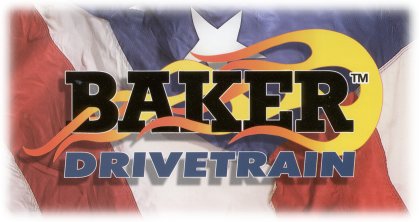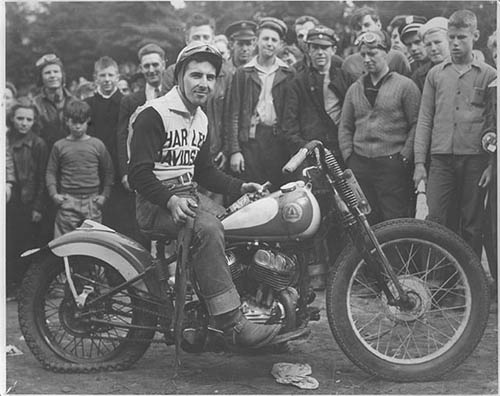

Here’s our secret Bonneville 2006 file. It‘s going to rapidly fill up with Bonneville racing info, notes, suggestions from experts, performance tips and lies. Check it out from time to time. It’s already interesting.–Bandit

TIPS FROM AL UNSER’S CREW
Back in the late 70's and early 80's I had the occasion to do work on Al Unser Jr's sprint car. During this time I met his dad Al Sr right after he won Indy. Since I was racing funny cars we got into a conversation about what helps make cars faster. He told me that on an Indy car, every part of the body and chassis is coated with Armoral. You know the stuff you put on your dash to brighten up the look.
It seems that the Armoral coating is more slippery to the air and will improve the speed of an Indy car by about 2 mph. Might be useful to you if you coated your leathers and the bike before a run on the salt.
–Dave Benjamin 617FC


BIKERNET BONNEVILLE TEAM SECRET FILES
Bonneville is the Holy Grail for many racers. It’s a far reaching, flat, moon scape of 65 square miles of salt. It’s a place for speed, real speed, top, all-out speed. We have three teams going so far, Chop and Grind from 13 Palms, California, Custom Performance from Phoenix and the Headquarters crew, or the 5-Ball Racing Team with Custom Chrome, Accurate Engineering, Baker Transmission and Departure Bike Works. We will share info, tips, connections, parts, you name it. Below is a performance exhaust lesson from Kenny Samson, the founder and head cleaning lady, at Samson Exhaust. Check it out:
The best thing to do is to start at the port diameter for flange fitment ofthe particular head. It is usually 1 3/4″ on most Harleys but the 45 may be1 5/8″. The rule of thumb as starters is to make each step about 8 inches long.The steps should be no more than 1/4″ increases but for fine tuning 1/8″increases would be better. The overall length is also important as well asthe step lengths.
I think you know Wink Eller, he ran our pipes on his RedOctober bike that were straight 1 3/4″ cut to the best performing length. Itdoes get involved and one set of pipes will not get you what you want. It'sexperimentations on section lengths, diameters, and overall length thatmatters.
Keep in mind that torque and horsepower are two different thingsand to get the best HP you need free flowing pipes but to get best torqueyou have to figure velocity into the equation.
My best advice is to buildyour engine the best performer you can with compression and cam lift,duration, timing, head flow, combustion squish and swirl, and blue printedto make sure the old cases are as square as possible.
Most Panheads tend towarp on the barrels base areas of the cases toward the cam side as well asthe lifter block surfaces. Don't forget to square the barrel bases to thebore as well. You don't want the piston going up and down cocked in thebarrel. This is a very common occurrence I think most people don't have aclue about it, unless they have done some of this stuff before. I have squaredmy engines in the past and kicked ass on other people with the same cam,bore, stroke, compression, etc and it was just fun to know what I did andnot tell.
By the way, engine case distortion is almost a definite issue.It's easily fixed by a skilled machinist who knows not to fuck it up.
Enoughranting…… geez I haven't had to think this much in a long time and yougot my gray matter in a mush.
PS reversion cones only inhibit high flow and are mostly for low to mid range power by increasing velocity.


BIKERNET BONNEVILLE EFFORT RESEARCH BEGINS
Seeing as how you plan to go 200 MPH, and seeing as how I am probably the only guy at Bikernet who rides fast bikes on a regualr basis, I thought I'd better chime in with some ideas for you mate.
Describe or send me a pic of what your speed demon is going to look like when you race it.Is it going to have one of those fully enclosed canopies, ala the Worlds Fastest Indian and the original Easyriders type salt flats bike or is it going to be just a normalish looking two wheeled machine?I am guessing the latter.
I am also guessing your going to have some kind of windshield or fairing at the front and sides of the bike?Ideas are changing in the sports bike world about weather an angular, sharp shield is more effective than a smooth curved shield.
I think sharp and angular is ok if there is no strong side wind. Flat panels get wind blasted.
Now you can save weight by not having any brakes…I kid you not.You can also save weight by having very small ones and a smaller disc than most on- road bikes use, like a lighter disc from a trailbike.Aluminium handlebars. Aluminium as much as you can actually!
I am going to take a look at some stuff I have from the UK 200 MPH club, I recall they had some useful info, just can't remember it all.
Assuming you are riding a bike and not lying down inside a rocket canopy…what's your thought on the gear your going to wear?Some of the new full face helmets, like Nitro, have wind deflection scallops on the back, great idea.When you're doing real fast speed on a bike you need to cellotape (sticky tape) the visor shut. Have someone do it just before you take off. People say with modern visors you don't have to… At 200 MPH I would not be taking any chances it might flip open myself.Make sure the helmet is a real tight fit also.
If it's very sunny and the glare is a problem, apart from a tinted visor; grab a roll of black electrical tape, the half inch wide vinyl stuff. Lay one strip across the top edge of the visor. Then one below just overlapping the first piece a little. Keeps the sun out of your eyes.
Race skins, leathers; tight form fitting ones with as much body armour as you can stand. Or…get a body armour zip up jacket outfit, connected by mesh, and put your riding jacket over the top. Some street racers now put the armour mesh over the top of their jackets to save the leather, the armour mesh outfit takes the brunt of any impact.Most mesh armour now comes with a good back protector also.
Gloves…personal choice as to what you want of course, but make sure they come well over cuffs of jacket to stop any wind going down sleeves of jacket, it's all wind resistance you don't need. Collar needs to be round and a good fit, to stop wind blasting down the neck area. Can be padded out by a folded bandana.
Leather pants tucked into smooth leather race boots, wrap some of that silver plastic tape, the two inch wide stuff, around top of boot…stops wind deflecting around top of boot. Like a seal. If pants are a bit loose around the knee area, wrap more silver tape above and below knee after you get on bike.The end of all the tape needs to facing away from the direction you are travelling in. So the wind actually presses the tape tighter!
If you're wearing a two piece jacket and pants outfit, more tape wrapped around waist to join suit together and not let any wind get up under jacket. It all slows you down.Some guys even polish their jackets before they do speed runs!
I am sure there is tons of stuff I have not thought of.Here is something new from the UK MC news desk…they say that studies have proven that synthectic oil DOES NOT cause any clutch slippage whatsoever, that it is a myth.They say if your clutch starts to slip after you use syn oil, clutch was probably on the way out and the better oil simply showed the problem up because the oil is so much “slipperier” I am still thinking on that suggestion.
— Jaq.


